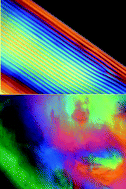We compare the phase behavior of a mutant filamentous virus, fd Y21M, to that of a conventional fd wild-type (wt). We find significantly different macroscopic phase behavior despite the only microscopic difference between the two viruses being in a single amino acid of the major coat protein pVIII. Compared to fd wt, the location of the isotropic–cholesteric phase transition for fd Y21M shifts to lower densities. This is attributable to a significant difference in the flexibility of the two viruses. The persistence length of fd wt is 2.8 ± 0.7 µm, whereas the persistence length of fd Y21M is 9.9 ± 1.6 µm. The large persistence length of fd Y21M makes it an essentially rigid rod, thus allowing for the first time a quantitative test of the Onsager theory for the isotropic–nematic phase transition. Even more striking, is the difference in the chiral phase behavior of the two viruses. Both viruses form cholesteric phases, with the fd wt forming a left-handed cholesteric helix, and the fd Y21M forming a right-handed one. At a given density, the magnitude of the cholesteric pitch between the two systems is different by fivefold. Using mixtures of the two viruses, we create a liquid crystalline system with a tunable control over its macroscopic chirality.

You have access to this article
 Please wait while we load your content...
Something went wrong. Try again?
Please wait while we load your content...
Something went wrong. Try again?


 Please wait while we load your content...
Please wait while we load your content...